digital colonialism in performance practices
This is a research on how the violence of digital colonialism can be transformed into resources for performance practices, connecting it to native and traditional performance practices, and making use of the same resources as a form of resistance.
This work gathers many configurations of data colonialism in today’s globalised technological structures, to then investigate how these can be used to expose these situations by applying the same mechanism to performance practices. The research develops ways to appropriate these structures into performative scenarios with native and traditional methods of creation, using what is the venom as the cure. I believe that the only way to acknowledge and slow virtual imperialism is by searching for direct connection with diverse and plural voices, through digital means themselves.
I am especially interested in working with native creating processes of performance because these communities are as violated today as during colonial practices from 1500 years ago. Even though data colonialism is physically different, its function is the same, which is to desposess and extract from these communities. I intend to claim this violence and transform it, with a bit of acid humour, into a trigger for performance pieces. My intention is to assert these practices as a co-directing tool for the scenes, abolishing the hierarchy between people and machines and the understanding that digital is less real than physical.
The research consists of three parts. The first one investigates which structures and devices are the base for this exploitation, and how these can be reclaimed as a form of resistance. The second one is focused on how these tools can be used together with native and traditional performance practices, to connect the processes of creation of these communities. The last one consists of prototypes of performative use for each structure that will be claimed as a form of resistance, and the contact with other artists from colonized countries to share their critics, perspectives and perception of reality without the fog of data colonization. During the period of the work, I will use this space to share the research before uploading a detailed report.
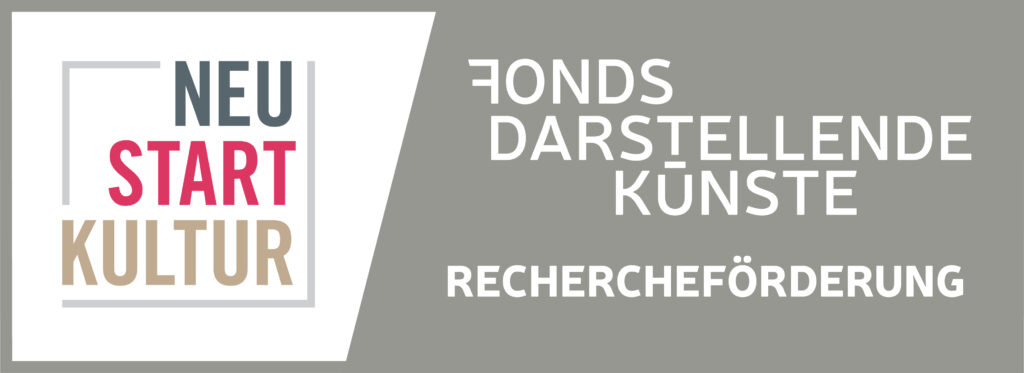
The first month of research was dedicated to investigating the configurations of data colonialism in order to better understand the structures and devices used as a base for digitaal exploitation. During this period, it was noticeable that these configurations were not similar to physical colonialism, but in fact, colonialism in virtual spaces. Therefore, as a point of start, I researched how these methods of exploitations used to be performed in the physical setting, to then observe how they function in the digital era. For each configuration, I analyzed the structures and devices used for that, to then assert these practices as a tool for performative use, driven by the following questions: how can one claim this violence and transform it, with a bit of acid humor, into a trigger for performance pieces? How can these practices be asserted as co-directing tools for the scenes? Is it possible to absolutely abolish the hierarchy between people and machines, by creating environments where virtual and physical are at a co-creating level?
After that, the second month of research was focused on how these tools can be used together with native and traditional performance practices. The intention is to connect the processes of creation of these communities, with a mixture of disciplines and strong reference to ancestry, sharing directly or indirectly the history of resistance of these groups. These were either folklore based, sharing rituals and creative methods, or based on the state of attention of the performative body in these places, relating traditional practices with the tools investigated in the previous month. This was mainly a series of investigations of the tools being connected to native creative processes, with practical examples and documentations of experiments in foto, video and any technical explanations necessary to implement this use.
Right after this process, I got in touch with other artists from colonized countries to share their critics and perspectives in order to understand these groups’ perception of reality without the fog of data colonization, and shared the theoretical and practical research with them in an informal workshop following the structures below. With this, I was able to re-interpret their insights to imagine how these prototypes can reflect their truth without the deterioration of their social lives. With this augmented perception, six concepts of performances were built, with prototypes of the use of each colonial structure on scene, claiming the tools of data colonialism as a form of resistance.
The report is structured as the following. Please, be aware that the items about colonialism describe graphic content.
0.
Digital structure: Which structure, configuration or misuse of resource implies violence and exploitation in digital environments, or physical environments with use of digital means.
Digital colonialism: How and why this falls into the category of colonialism and violence.
Physical structure: A comparison of the digital structure to similar ones used in physical colonialism.
Physical colonialism: A historical context of how this exploitation happens or used to happen in physical colonialism
Native practices: Example and social context of cultural traditional or native practices or rituals to be applied with the configurations to create a performative proposal.
Performative proposal: A skeleton of possible performance structures that use the past items as a trigger for the scene, reversed into a tool of free experimentation to reclaim these as a form of resistance.
Prototype: Registers of experiments made in order to build the performative proposal, showing visually and/or technically how it would work.
˜*˜*˜*˜*˜*˜*˜*˜*˜*˜*˜
1. Invasion of private devices
Digital structure: Invasion of private devices
Digital colonialism: Hacking can come in many forms and used for many purposes. Here, I specifically address the use of this resource done by authorities and figures of power, or individuals defending authority figures. Examples of the goals of this use are to expose someone’s identity when they do not agree with authoritarian use of power, or to illegally invade someone’s property or arrest them because of extreme political beliefs. A real life examples of this action is below.
Moiz Butt, 17, and his brother Muneeb, 15, were beaten to death after the leak of a security video containing a robbery. Police and emergency teams were present and supported the lynching. They were mistaken with the robbers by the population and murdered in a beating mob, which was filmed and posted online. Both teenagers were innocent.
https://en.wikipedia.org/wiki/Lynching_of_Mughees_and_Muneeb_Butt
Physical structure: Invasion of territory
Physical colonialism: As widely known, the base of colonialism is the invasion of territories with the goal to enslave natives and exploit natural resources. One of the thousands of examples of this practice is the invasion of South Africa by the Portuguese in 1500, where thousands of South-African people were enslaved, tortured, arrested, then put in cages inside ships that brought them to Brasil. When arriving in the country, in 1500, not only the colonizers inserted the enslaved people into an infinite cycle of torture, humiliation and unpaid labor, but also violently raped and killed native indigenous Brazilians living there.
Native practices: For this prototype, a mixture of traditional rituals and the mental state of performers in regions of socio-political vulnerability. In terms of form, the live version of the performance illustrates clearly what is the sensation of living in constant state of alert within your own body, and offers the audience the possibility to critically reflect on how their practices up to this date impact the culture of communities that live in constant fear. Also, this makes reference to Latin American popular dance rituals, in which a narrative is shared in yearly events but the order of the scenes and the specific materials being used to construct the characters change the story itself. See examples below:

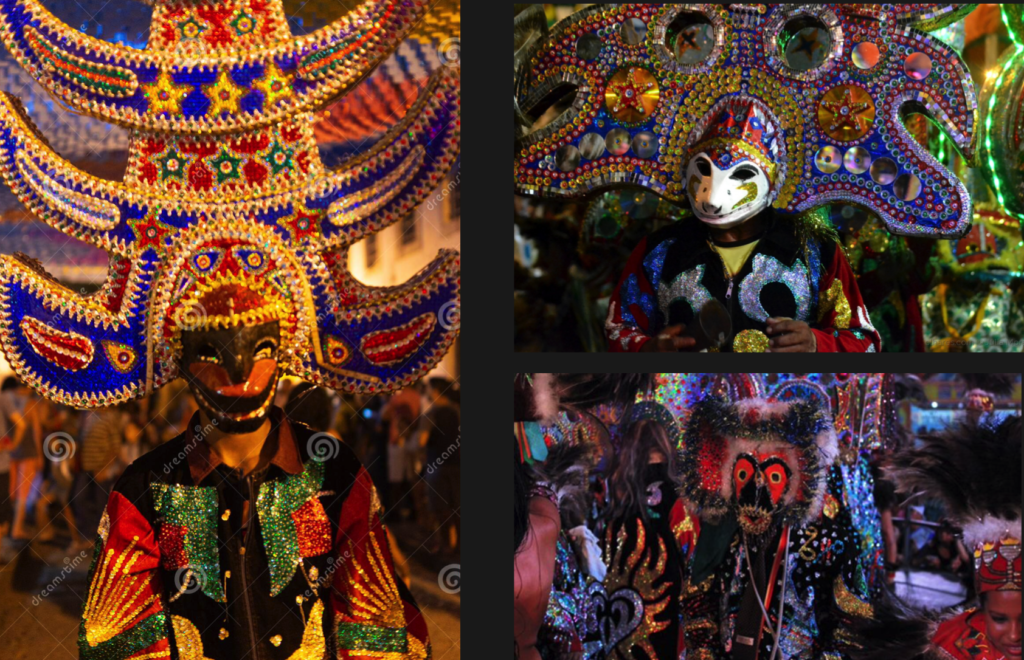
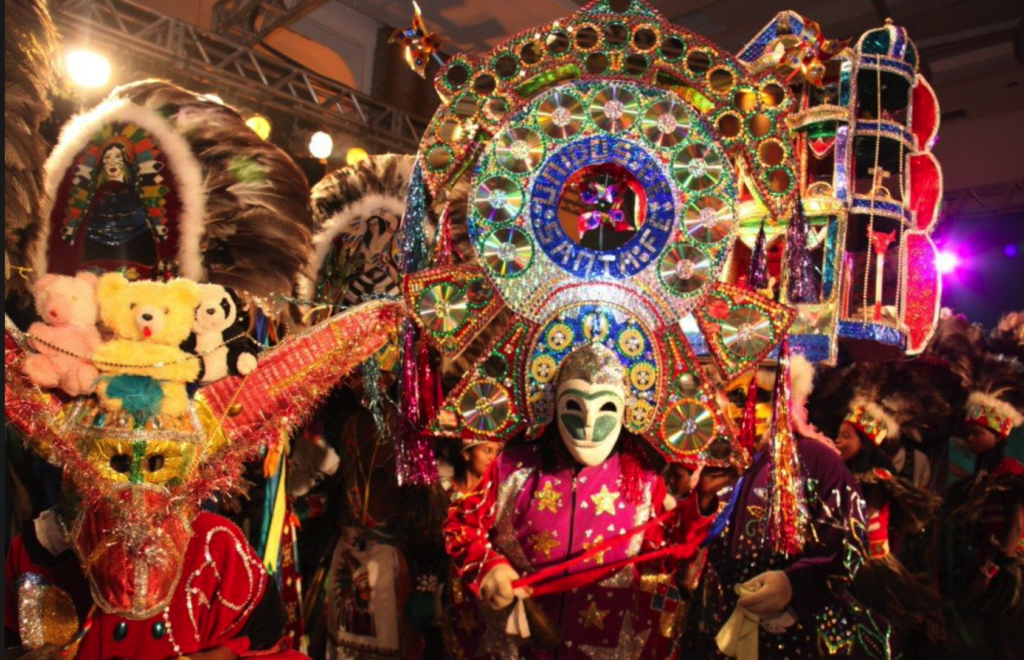
In this example, Bumba-meu-boi, traditional Brazilian cultural practice in which the narrative is partially told by elements in the materiality of the piece. The is a previously created base narrative, elements change details of it and the reason why it’s being told.
Performative proposal:
- Steal my eyes (offline)
A piece that cannot be watched twice, because the story depends on the variable order of scenes. Dozens of scenes are pre recorded, each making sense individually. Any composition of scenes would make some sense when the following scene is watched after the previous. There is only one beginning and one end possible. The public is inside a space with many screens. They decide which scene goes next by clicking buttons. This is either a collective decision, by putting some sort of basic information of the scenes on the buttons; an individual choice, if someone tries to press a button faster than the others without asking their opinion; or a “random” choice, using cameras to track visual information about them that will decide who choses or which scenes go next. For example, if someone passes a certain point in space, if someone is wearing a red hat, if someone talks too loud – this person choses. The cameras used for this should be PTZ (point, tilt, zoom) cameras, since they can be programmed to track specific information.
- Steal my eyes (live)
A similar and live version of the previous proposal. The difference is that, here, no scenes are pre-recorded, so the people on focus are the performers. Public and performers are in different spaces. The public has control of the PTZ cameras and chooses where to point them, by distance. Performers are constantly on trigger and ready to react. The patch of scenes is built by the audience. They also have to decide where they will point the camera at, based on little information.
Prototype:
In this case, since we had no PTZ cameras available, the prototype was done through “stealing” the camera of a person in an online call and that triggers their turn to speak.


2. Crimes against the honor
Digital structure: Crimes against the honor
Digital colonialism: These are offenses against subjective honor or objective honor, whether it is an offense to personal dignity or professional fame, removing from the individual’s right to personal respect. Here, I consider slander, defamation and libel. Although similar, they are very distinct. Slander consists of falsely imputing or attributing to someone a fact defined as a crime. Defamation is when someone creates a bad name for another person, thus damaging that person’s reputation. Libel is the action of offending someone’s honor and dignity. It means the same as to revile, to offend another. In the digital colonialism spectrum, this practice is used to impose biases, falsely accusing people from certain ethnicities and cultures of crimes.
Fabiane Maria de Jesus, 33, was lynched after a Facebook post accused her of being a witch. This post was made by locals when trying to find a cause for child abductions in the area, and went viral. Around 100 people beat her up and more than 1000 were present watching the scene. Until today, her daughter is trying to sue Facebook and get justice.
https://www.atribuna.com.br/noticias/policia/caso-fabiane-filha-de-mulher-linchada-ha-oito-anos-em-guaruja-ainda-luta-por-justica
Physical structure: Crimes against the honor
Physical colonialism: Similar to the digital practice, crimes against the honor in physical colonialism were, needless to say, also used as a form of violence and control. Both slander, defamation and libel occurs when privileged groups refer to race, color, ethnicity, religion, origin, or the condition of an elderly or disabled person used against the enslaved or less privileged group. This constantly puts them in an unbreakable cycle of submission and violence, being punished for crimes they don’t have the chance to defend themselves from.
Native practices: For this example, I’d like to focus on folktales from colonized countries. The reason is that in colonized countries, the colonizers’ religion is often seen as a base for virtues and moral values of those communities, and their original beliefs before colonization are categorized as folklores. Examples are myths, legends, games, dances, festivals, typical foods, and other customs that are passed down from generation to generation. In addition to that, those folklores reflect a community’s socio-cultural panorama, and up until today we can see how that constantly repeats and transforms itself. One example of the tale Negrinho do Pastoreio, an African-Christian tale also popular in the South of Latin America, originated in the mid-19th century during the Portuguese and Spanish colonizations. One of the versions of the story is that a farmer ordered a boy, his slave, to go and herd his horses. After a while, the boy returned and the farmer realized that a horse was missing. As punishment, the farmer whipped the boy until he bled and ordered him to go and find the missing horse. The boy managed to find a bay, but could not capture it, so the farmer punished him even more, by throwing him in an anthill. The next day, the farmer found the boy alive and unharmed, the Virgin Mary at his side and the bay horse. After the farmer asked for forgiveness, the boy answered nothing, mounted the bay and galloped off. Legend has it that until this date, Negrinho do Pastoreio is seen riding his horse through the fields. And whenever someone loses something, anything, they just light a candle asking for the help of the boy and his horse, and their request will be answered. Reflects of this tale are seen until today in violent colonial behavior still present in those societies. When seeing black people being beaten in the street, we are seeing an update in the myth of Negrinho do Pastoreio. When talking about this legend, we are talking about a story about racism and violence that cyclically present themselves within those communities.
Performative proposal:
- He said/she said
A piece with one narrative with several different points of view to be debated. This can be digital or physical. In case it is physical, it should either be in the form of installation or staged. If an installation, the public is free to access different rooms in the order they find more interesting. Each room plays a scene with the exact same duration as the others. The order in which the scenes are seen dictates the point of view of the narrative being shared. If staged, each scene should contain at least two happenings simultaneously. The piece doesn’t have to have spoken lines. If the work is presented virtually, it should be a digital universe with multiple truths to share a narrative. Similar to the installation, different digital rooms can be accessed in varied orders, so that the perception of the narrative has several possibilities. The difference between prototype 1 and 2 are the violence in differing narratives. Here, the audience has a completely different perception of each character depending on the narrative they watched, and who is “good or bad” within the story. Also, in this case there is one truth – which some may have watched, some maybe not. The audience is (gently!) tricked into believing absurd possibilities for the piece, to the point that they are sure this is what happened. In the end, they are informed of the methods used to make them believe absurdities, and how this is not true.
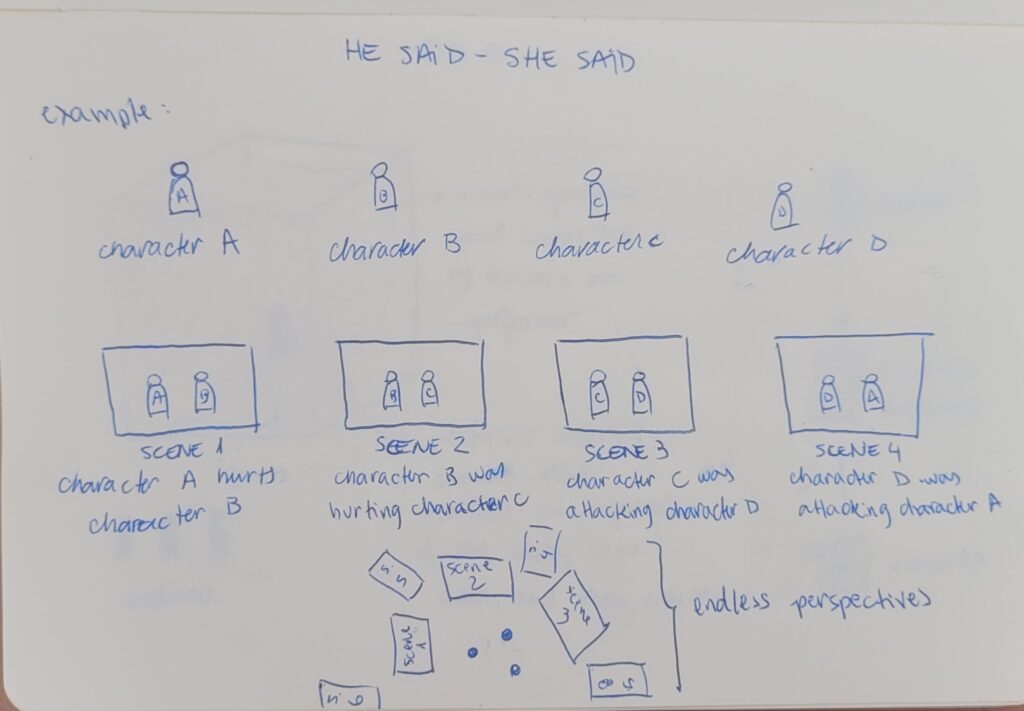
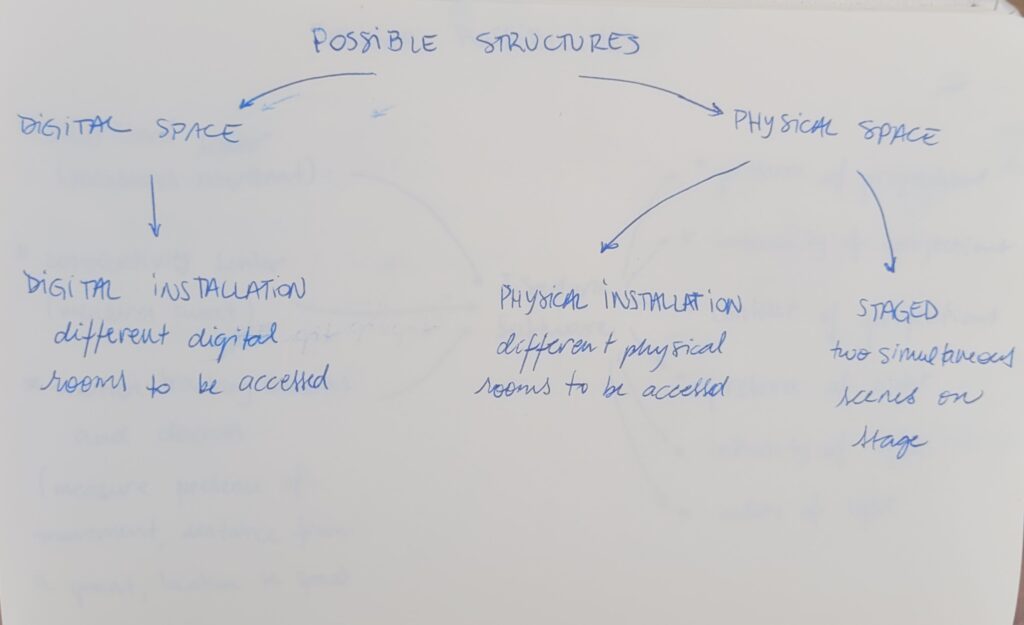
3. Espionage and big data exploitation
Digital structure: Espionage and big data exploitation
Digital colonialism: The broader example of some of the structures mentioned above. Espionage in digital colonialism settings can be done not only by illegally invading devices, but when getting private information without consent in any form – camera tracking on the streets, collection of online data in social media apps or health and wellness apps or devices, Data is sold and used to set up a consumer profile, by analyzing the person and redirecting advertisement of products that may be of their interest. This can also be seen as the person is actually the product, since their personal data is sold for big corporations so that they grow, and there is no actual benefit for the individual.
Physical structure: Extreme surveillance disguised as progress
Physical colonialism: For this context I will use the image of the Capitão do Mato (plural: Capitães do Mato), figures present in the colonial era of Brazil. The Capitães do Mato were responsible, together with military forces of the colony, to keep control of enslaved people who tried to escape or not comply with the violence. They essentially hunted people and delivered them to their masters, who, in return, paid them in cash. The Capitães do Mato were generally freed enslaved men, which guaranteed a higher social position than those who remained slaves and even the free poor population, since they were in a closer hierarchy to their lords. On the other hand, the slave origin of the Capitães do Mato further inflamed the anger of the captives against these hunters, since in the past they had been in a similar social position. They were extremely important in maintaining the cycle of violence through vigilance and control, and used as an example of “progress” of an enslaved person who “behaved well enough to deserve to be in this position of power”.
Native practices: For this prototype, the focus is on tiny daily rituals. It is believed that a cultural ritual is often a show, big presentations with shiny and colorful elements, specially in countries based on the South of the planet, labeling their knowledge, beliefs, leisure, or even themselves as “exotic”. This not only implies that anything done parallel to the North hemisphere is unusual or abnormal, but that a persons culture within the field of performativity is only alive in bold movement rituals, which is not true. So, in this proposal, there is a mixture of popular rituals where the identity is erased to give space on the performer’s body to a narrative, and tiny daily rituals from cultures of the South hemisphere.














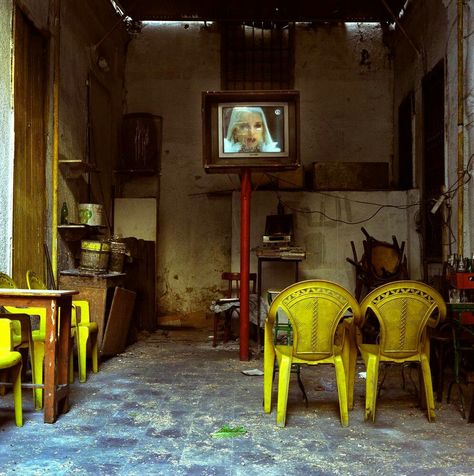


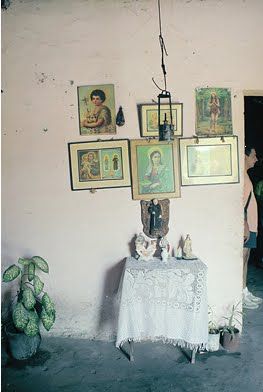

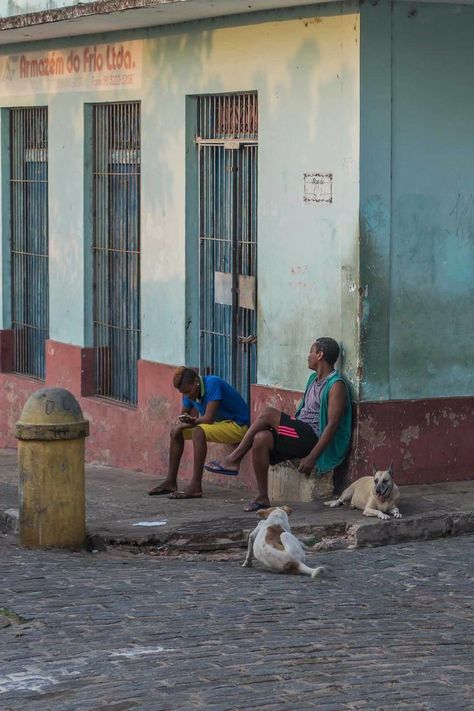
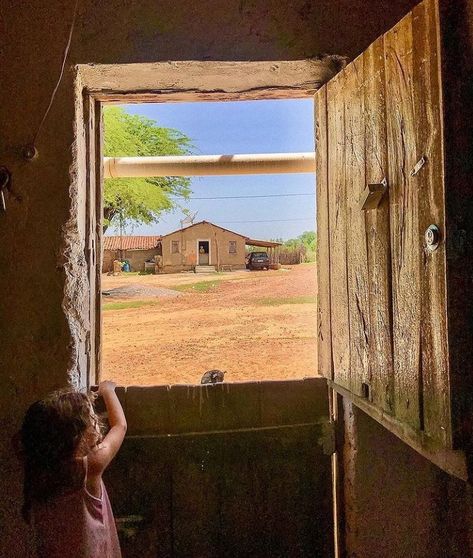
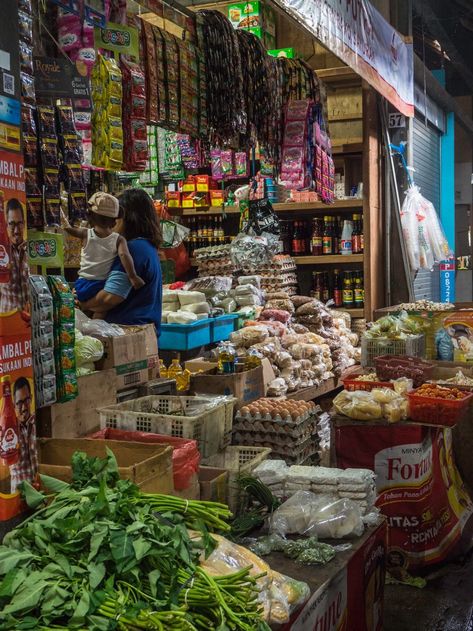
Mood board of textures, smells, visuals, sounds and tastes of colonized countries, which build their daily rituals, and therefore, their culture. When looking at this moodboard, you are welcomed to make the exercise of describing the senses you imagine you would feel in those settings, as if you were describing them to someone who doesn’t have this sense. For example, describe the visuals to a blind person, the tastes for a person who doesn’t feel tastes, the sounds to a deaf person, and so on. This description is the feeling that is tried to be shared in the ritual.
Performative proposal:
- BBB
A durational performance, with overlaying of data that translates into the space. The tracking and recording of the bodies performing are the starting point for the piece, which is then translated into visual information. The performers are inside a closed space, like an aquarium or showcase, to reinforce for the audience that they are not tracked like the performers – the outside space is their safe space. The data of the body is shown in the scenography around them, by converting it into sound, light or projection. The tracking can be made using different types of devices, depending on what is being tracked. In this piece, the tracings of the facial muscles reacting to tiny daily rituals that belong to the performer’s culture, when made when they are placed in a sort of cage in a European country. This is done using Infusion Systems sensors, connected to the Isadora Software, which translates the muscles movements into visual information with projections. However, different tracking structures can be done. For movement tracking, use a Kinect or PTZ camera. For insides – heart rate, breathing, muscle tension -, use sensors. Either the case, connect them to light, sound or visuals using the Isadora Software. If done online, the performer can be presented as a live hologram – either way, the data turns into scenography. The narrative is the data, the data is the narrative.

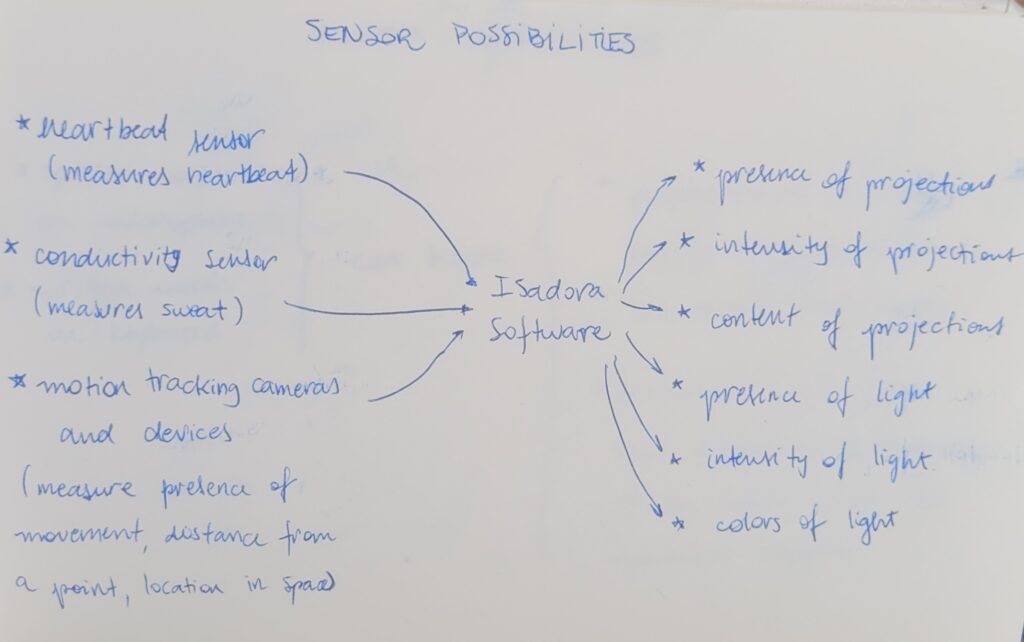
Prototype:
4. Cyber-bullying
Digital structure: Cyber-bullying
Digital colonialism: This practice may seem not as violent, but among the devastating consequences to the victims, it is also tightly attached to colonial behavior. Colonial practices were essentially the consequences of separating the North from the South, the “developed and underdeveloped”, “civilized and savages”, creating not only a physical distance between these nations, but also an interpersonal, cultural, economic, racial ones, among others. The figure of white, cisgender, heterossexual, christian, European males are up to this date used as a reference for “superiority”. Everyone who distances from this reference tends to be socially excluded, and that’s where bullying comes in. The verbal violence maintains this separation between what is socially recognized as superior, and the binary logic that composes social hierarchization, a micro tentacle of colonialism presented through dialectics.
Physical structure: Persecution of exploited people
Physical colonialism: Directing insults and moral aggression towards people in conditions of exploration, in order to maintain the cycle of oppression and keeping this community submissive to the point that they believe they should stay in that position. One of the most extreme examples is the imposition of christianism in the “civilizing mission”. This was a practice of Portuguese colonizers mainly in Moçambique and Brazil, a domination practice employed by the colonies claiming to be “a salvation for the savage peoples”, claiming that they were, in fact, helping them, not taking advantage of them. Among them are the Jesuit missionaries. The Jesuit missions in America were carried out by priests of the Jesuit Order to evangelize and “civilize” the natives of the land discovered by the European colonizers. Among the main objectives of the Jesuit missions in America was to design a society with similar qualities to the European one, but in order to do so, they taught natives that not only they were “less developed” than Europeans, but that they were inferior for not following christianism, or not even knowing it. Some defend this for bringing “civilization” to indigenous communities, who never asked for it and were put in a loop of erasing their own culture, maintaining them in the condition of inferiority.
Native practices: For this proposal, a tradition that is similar to the first one is used as a base for creation. The difference is that, here, instead of using materials to share a story, they are the story themselves. Feeling and sensations are induced through visual and haptic sense, giving an implicit message through senses and movement, as if it was a plastic autopsy of the culture that lives within the performer. One example is the Zangbeto, a cult of the Badagry people. Zangbeto appears on special occasions or when there is an urgent situation in the community. Someone becomes the ritual dressing, dancing and spinning in abrupt movements. At some point in the ritual, it is shown to the others that there is actually no one inside. Then, the body of hay is hit with a stick, and starts the frantic movement once again. See an example below:
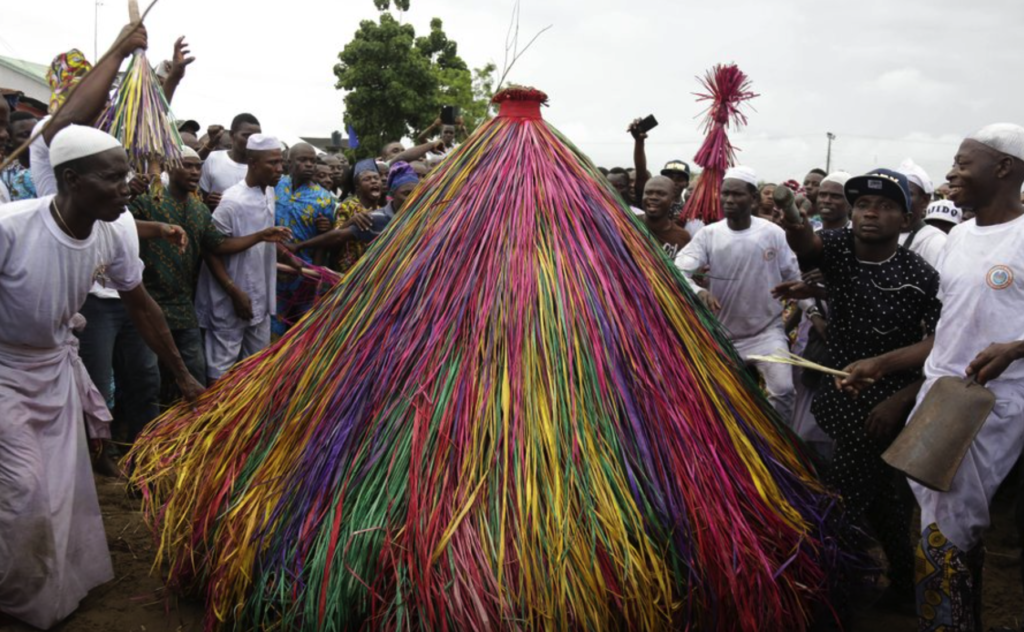
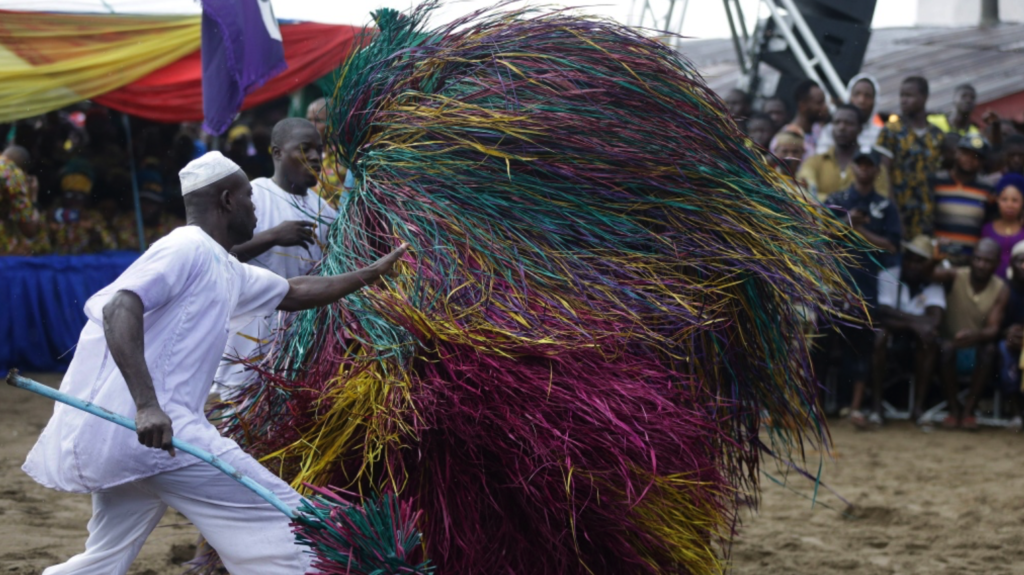



Performative proposal:
- data words
In this piece, the proposal is similar to the previous one in the sense that data is collected and translated into something else. In this case, the audience is invited to observe the scenes. No lines are being said, and they are invited to speak in microphones of the space phrases or words that they believe connect to the happening. The microphone does not project their voice out loud. Instead, it is used with speech to text to translate what they are saying into an indumentary, by projecting the result on the performer’s body or a point in space using mapped projection. Their words are sometimes translated into written words, sometimes into colors or forms. This is the queue for the performer to build their persona. They do have a linear narrative to share, but it is neutral in terms of personality. Their patchwork-personality is built live, depending on the audience. Ideally, this piece has two or more performers on stage.

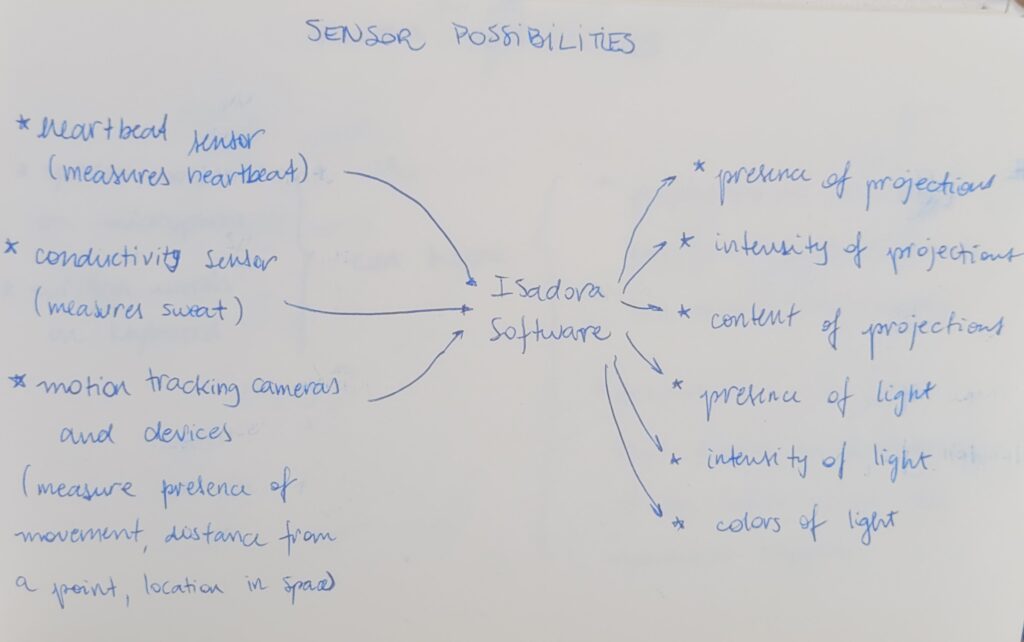
Prototype:
5. Endless scrolling
Digital structure: endless scrolling
Digital colonialism: Endless scrolling, or infinite scrolling, allows users to browse a large amount of content without a visible baseline. This technique consists of simply refreshing the content as the user scrolls down, which makes them interact more with the content and stay on the social media for longer periods of time. The idea was to replace a layout known as pagination, a traditional approach that breaks large lists into several smaller pages, with a more intuitive one. Pagination allows users to select specific content, but forces them to “overthink” what they want to see. This structure allows the app to keep the user in a hook of consumption, surfing indefinitely, because the amount of content offered is infinite. Since there is no previsibility – everytime the page is updated, new content comes up, we keep scrolling the screen in a continuous flow, behaving similarly to what occurs in other addictions, such as drugs, alcohol, or gambling. The cycle of trigger, action, reward and investment generates feedback loops that keep users active, and consequently, their data and consumer profile is built with more accuracy. Basically, this is the perfect mechanism to endlessly retain users’ data – their time is the product.
Here are some testimonials of people involved in the creation of Endless Scrolling.
Aza Raskin is the creator of Infinite Scroll. The young prodigy, who now campaigns against addictive technologies, told the France Télévisions channel last year that his invention “costs humanity the equivalent of 200,000 lives a day.” It’s a calculation he made himself, and Aza Raskin finds the result “frightening.” So much so that he is working on a process that slows the flow of reading as one scrolls through the pages.
Sean Parker, former president of Facebook, admitted that the world’s most popular network is designed to lure users with postings of dopamine, the famous “pleasure hormone.” “We exploit a flaw in human psychology, we understand it, and we make (mis)use of it anyway.”
Chamath Palihapitiya, another former Facebook executive, said he felt “terribly guilty” because “we all knew something bad could happen.” These short-term feedback loops we have created, fueled by dopamine, are destroying the way society works: no civil discourse, no collaboration, with misinformation and lies. Today he says he is doing everything he can to keep his four children as far away from digital technologies as possible.
Tristan Harris, former product manager at Google, is one of those who feels the most remorse. He has spent the last few years encouraging people to use less of the technologies that he himself helped create. And he has done so through Time Well Spent: an organization he founded in 2015 and turned into the Center for Human Technology three years later, at the head of which you will again find Aza Raskin, the creator of Infinite Scroll.
https://www.swissinfo.ch
Physical structure: False freedom after end of slavery
Physical colonialism: Even though slavery was abolished in most colonized countries decades or centuries ago, descendants from enslaved people in these communities rarely are as free have the same privilege as descendants from colonizers. The inequality still puts them in poor living conditions because of the lack of opportunities those families had by the “end” of the colonization process. Without access to education, lands or proper jobs, as well as the poor conditions and low wages guaranteed the formerly enslaved people a subordinate and marginalized position in society. Poverty and lack of opportunities contributed to perpetuating this portion of formerly enslaved people in marginal positions in our society, which contributed to the growth of crime. Those people entered an endless cycle of marginalization and domination that exists up to this date.
Native practices: Here, the cultural reference is the ritualization of trauma in societies that have been through extreme social, political, economic, territorial or cultural violence. There is a movement of reclaiming the identity through the development of cultural practices that share the story of this people, either by telling again this narrative of violence from their perspective, or making use of native materiality to build the persona. This is done by superimposing materiality to build an external body, an exoskeleton for performance that sensorially reflects the history of that people. The performative proposal makes reference to this practice from the creation methods – a narrative is built by starting from the same cultural exercises made to ritualize trauma – a modern ritualization of modern traumas through ancestral creation processes. You can read details about the co-relation between performance, materiality and social trauma in another research I’ve done, by clicking here. See an example below:




Restart of the New Years eve celebration of the Luanda-cokwe community after 40 years of suspension, showing their resistance from the Portuguese colonization that “asked” for cultural submission of that community with promises for better life conditions.
Performative proposal:
- X takes to X
This piece is a bit different than the previous ones, in structure form. Instead of a live performance, I would call it a performance that is alive. The audience chooses what to watch and how to compose the narrative. The scenes are quick, a sequence of photos-memories, composing a stop-motion like video of feelings and sensations. The first scene is presented in a 15 second composition. They are instructed to slide down to the next scene as soon as they feel it is time to do so. Depending on the moment they slide, a following scene is then played. For example:
- Start – Video 1: Scene A
- Next on second 4: Scene B
- Next on second 8: Scene C
- Next on second 12: Scene D
- Video 2: Scene C
- Next on second 4: Scene E
- Next on second 8: Scene F
- Next on second 12: Scene G
And so on. The audience subconsciously choses the narrative, and there is no way to change their choice and look for an alternative story. Since there are thousands of possibilities, it is almost impossible that two people will experience the same.
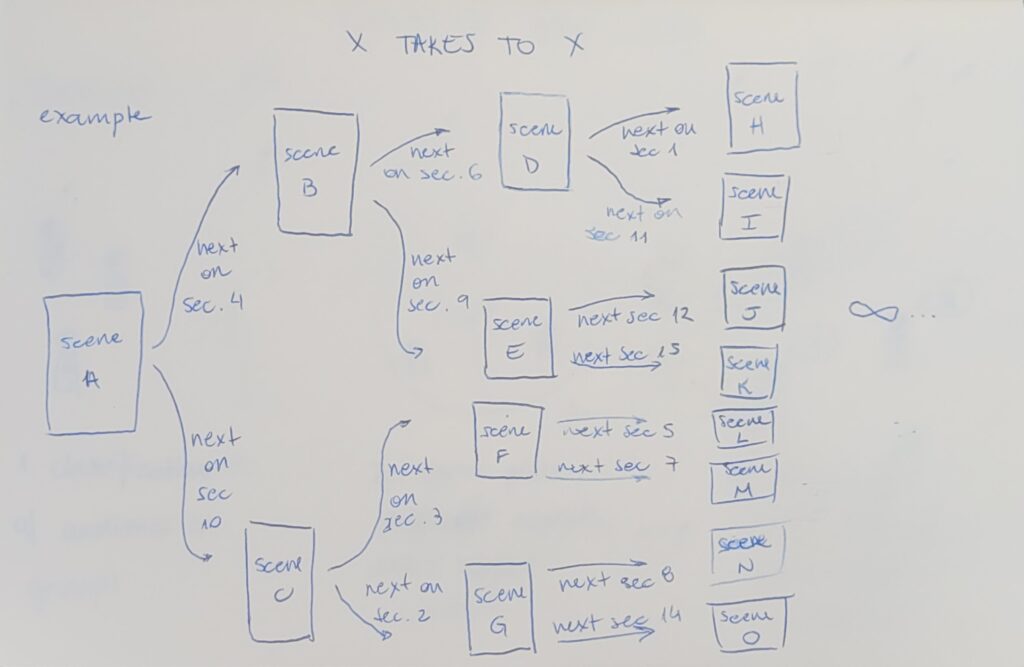
Prototype:
6. Dissemination of false or partially altered information in politics
Digital structure: Dissemination of false or partially altered information in politics
Digital colonialism: One medium for that is the use of social media apps that don’t consume much data usage of cellphones, like Facebook, to be the main source of information in countries that don’t have much access to the internet. Information can be published without a verified source and shared indefinitely. More complex schemes of fake news spread also include partially true information, mixed with false statements so that these are more believable and harder to identify. This also includes shocking and ambiguous headlines, so that the link is never actually opened – the headline is the message. Scandals using this technique include the elections of Donald Trump as the north-american president and Jair Bolsonaro as the Brazilian president.
Physical structure: Dissemination of information about decolonization, eurocentrism, information deprivation
Physical colonialism: The topic I would like to bring up here is not exactly a colonial practice, but the smooth perpetuation of disinformation about it. The structure is the same of the above, with the specification that the content is always related to misinformation around history, so that these practices don’t seem as bad as they actually were, to the point that people ask for these practices to come back without knowing what this means.
Native practices: The practice that this proposal makes reference to is the technique used by enslaved citizens to create and express art during colonial times, and how their descendants ritualized this practice. In this case specifically, Maracatu’s origin dates back to Colonial Brazil and consists of a mixture of African, Portuguese, and indigenous cultures. It shares the events of coronation of the kings of the Congo. The King of Congo was a figure that emerged to administer the people brought to Brazil to be enslaved. In this way, the Portuguese colonizers encouraged the tributes paid and used the coronation as a technique of domination. With its end, the ironic and playful cortege emerged, often mocking images of domination and colonization, which represents a symbolic court and became part of their culture.


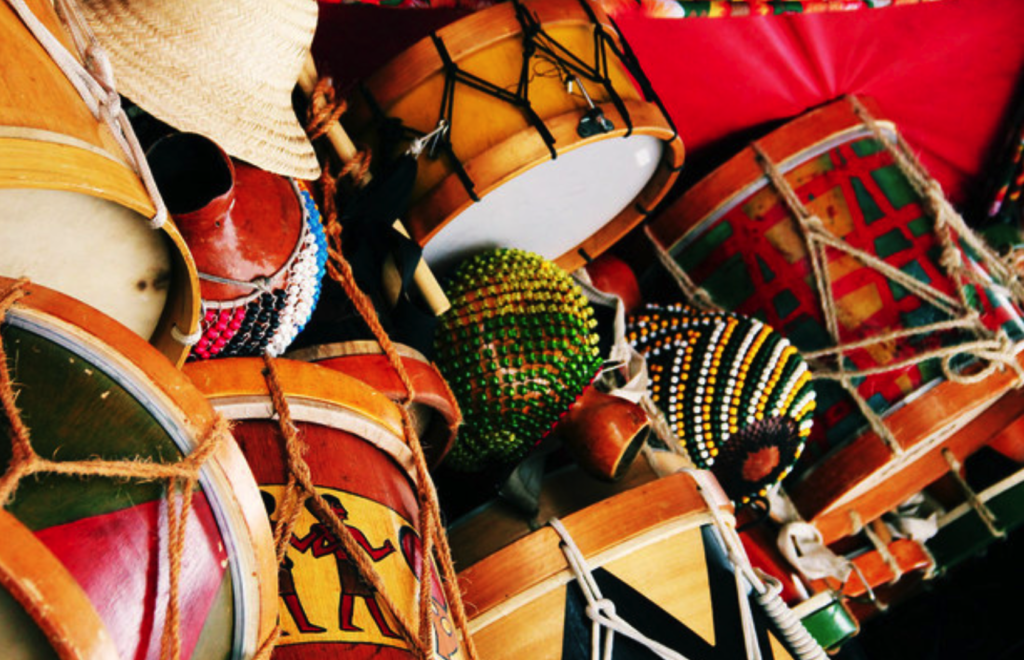
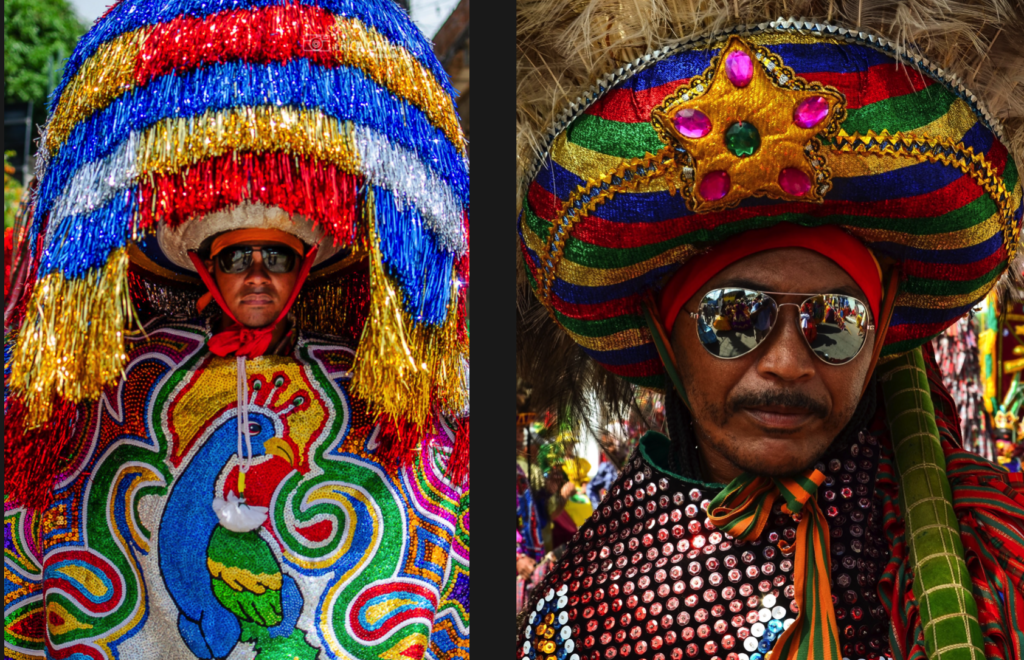
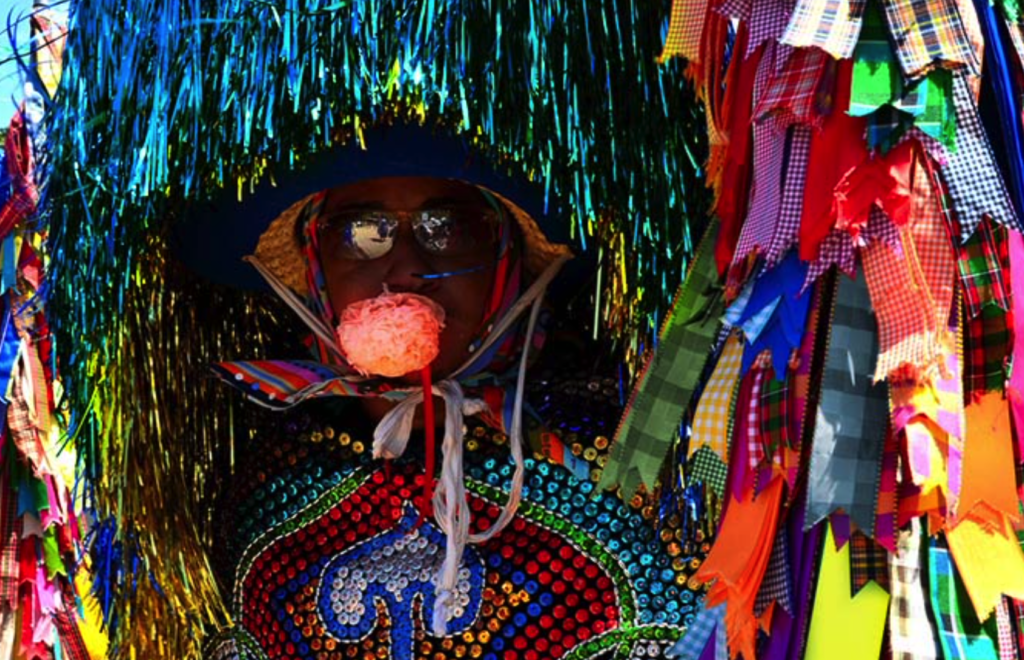
This is Maracatu, another popular practice of the northeast of Brazil. One of the characters, Caboclo de lança, is represented by painting their face and their scarf red with urucum, a tropical fruit with many uses – among them, corporal paintings in cultural manifestations.
Performative proposal:
- Relative absurdity
Before the performance, the audience passes through a quick and playful interview as a group, where their patterns and political opinions are evaluated. They are separated into groups that identify with each other – similar interests, experiences and opinions. Each audience experiences the narrative from a different perspective, chosen specifically to make them share the belief of that point of view being the absolute truth. After the performance, they discuss with their own group and write in a few words and phrases what they believe has happened. All perspectives are shown to the other groups. The intention is that each perspective is believable to the own group, but seem absurd to the others. For those who are interested, after that, it is shown how they were taught to believe an absurdity, and how all perspectives are equally true.
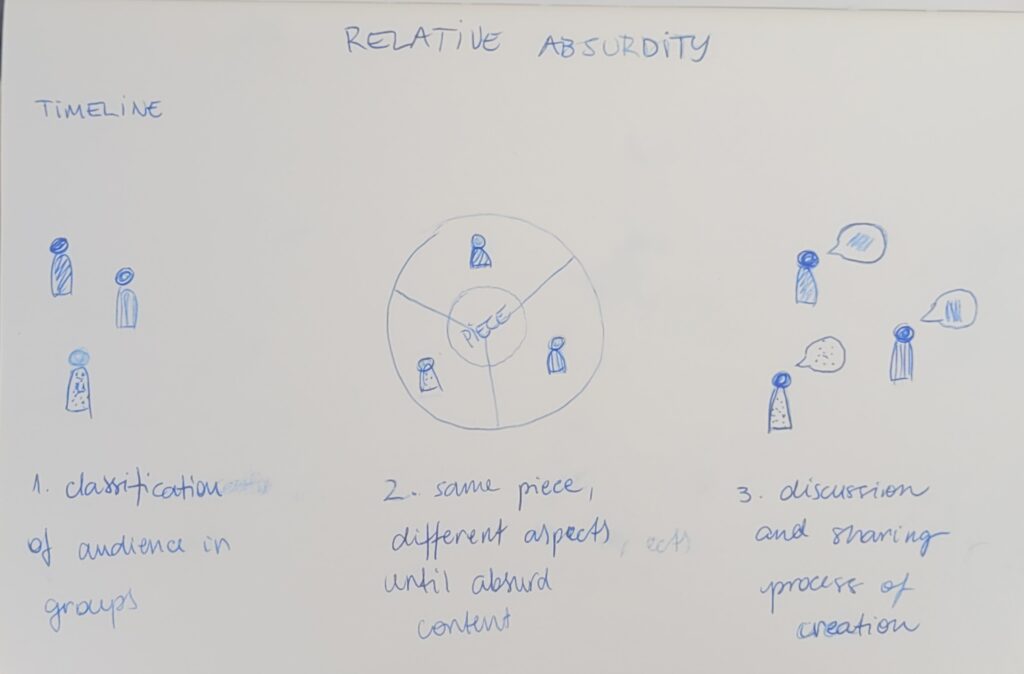

˜*˜